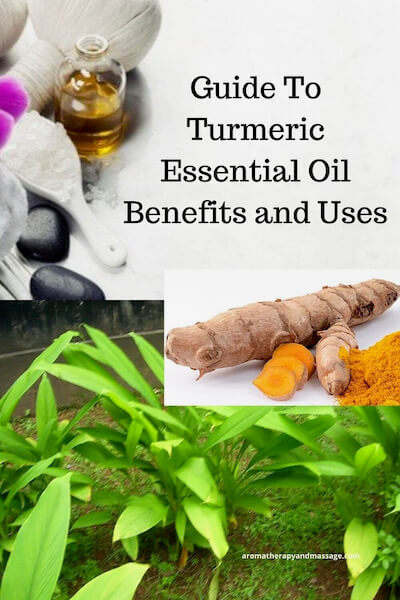- Home
- Essential Oil Profiles
- Turmeric Essential Oil
As an affiliate with Bookshop, Amazon, and other programs, I may earn revenue from qualifying purchases through affiliate links. This does not affect the price you pay. Privacy Policy / Disclosures. This site is for educational purposes only.
Search this site:
Guide To Turmeric Essential Oil Benefits and Uses
Turmeric (Curcuma longa) is better known as a spice than an essential oil. Turmeric essential oil may have some of the same benefits as the powdered spice but don't assume research showing the benefits of turmeric (or curcumin) powder means the oil has those same benefits.

Plant family: Zingiberaceae. Other essential oils in this family include ginger, cardamom, fingerroot, plai, and white ginger lily absolute.
Production: Steam distilled from the dried roots (rhizomes). Note: A leaf oil is available but not common—the components and properties of the leaf oil are different from those of the root oil.
Aroma: Spicy, earthy.
Perfume/Aromatic note: Base
Is turmeric essential oil safe to use during pregnancy? Sources disagree. Consult a professional.
Is turmeric safe for children? Probably, properly diluted. Consult a professional.
Cautions: The bright orange color might stain clothes and other surfaces.
Main components:
- tumerone 8.0–28.4%
- ar-tumerone 15-5–27.5%
- zingiberene 11.6–16.8%
- alpha-phellandrene 0.7–12.8%
- beta-sesquiphellandrene 8.8–9.5%
Source: Essential Oil Safety, 2nd Edition
Turmeric Aromatherapy Benefits
The Complete Book of Essential Oils and Aromatherapy: Uses of turmeric essential oil include help helping relieve gastrointestinal conditions, indigestion, stomach cramps, intestinal spasm, general aches and pains, and rheumatoid arthritis.
The Encyclopedia of Essential Oils (updated edition): Use turmeric to promote circulation in muscles and joints, including to help relieve arthritis, muscle aches and pains, and rheumatism. Digestive system uses include helping relieve sluggish digestion and liver congestion.
375 Essential Oils and Hydrosols: The oil helps relieve pain and acts as an aphrodisiac.
Aromatica: A Clinical Guide to Essential Oil Therapeutics, Volume I: Turmeric is a warming stimulant, helps relieve the pain of rheumatic conditions, and acts as an aphrodisiac.
The Complete Guide to Aromatherapy, Third Edition, Vol. 1: Turmeric may help relieve digestive problems, liver congestion, arthritis, and rheumatism. Suggested blends:
- To relieve indigestion: black pepper, sweet fennel, ginger, sweet orange, or rosemary.
- To relieve inflammation associated with arthritis and joint pain: black pepper, cajeput, ginger, kunzea, nutmeg, spike, lavender, or rosemary.
For making perfumes, turmeric blends well with other spice oils, such as galangal, ginger, black pepper; with sweet citrus oils such as mandarin or sweet orange; with sweet florals such as ylang ylang or jasmine absolute; and with resins such as benzoin or cistus.
In Traditional Chinese Medicine, turmeric is warming and helps dispel cold conditions associated with the digestive, respiratory, and reproductive systems.
Essential Oils: A Handbook for Aromatherapy Practice: In Ayurvedic medicine turmeric is bitter, astringent and pungent, and hot. This oil balances the doshas but an excess can aggravate vata and pitta. The oil is used to purify and protect.
Aromatics: Turmeric essential oil may help break cycles of chronic worry. The oil's comforting effects may also help relieve sore muscles and joints and help the body naturally restore itself.
Mixing Essential Oils for Magic: Turmeric's strong purification powers enhance the flow of energy. The oil grounds and centers energy, builds confidence and courage, and invites stability and longevity.
Turmeric Essential Oil Uses and Blends
DIY Turmeric Face Mask
Turmeric oil may help dry out breakouts and reduce the appearance of fine lines and wrinkles.
- 2 ounces (1/4 cup) bentonite clay
- 2 tablespoons avocado oil or other carrier oil
- 3 drops turmeric essential oil
- 2 drops patchouli essential oil
- 1 drop rose absolute or essential oil
- Mix the ingredients until completely blended. You want a thick, paste-like consistency.
- Wash and dry your face.
- Spread the mask over your face, avoiding the eyes.
- Leave the mask on for 10 to 15 minutes. Wash off with warm water.
Source: Eden's Garden
Scalp and Hair Serum
Blend these ingredients in a glass container:
- 5 drops turmeric essential oil
- 5 drops rosemary essential oil
- 2 teaspoons jojoba oil
- Massage the blend into your scalp.
- Let sit for at least 30 minutes or as long as overnight.
- Wash your hair as usual.
Source: Rocky Mountain Oils
Sore Muscle Rub
Add these essential oils to a two-ounce squeeze bottle:
- 5 drops turmeric
- 5 drops rosemary
- 8 drops copaiba
- 2 drops peppermint
Fill the bottle with jojoba oil. Shake to mix well.
To use: Massage a small amount of the blend into sore muscles.
Source: Eden's Garden
Photo Credit: Root and powder: Simon A. Eugster, CC BY-SA 3.0, via Wikimedia Commons. Turmeric plant: Rajaramraok at English Wikipedia, Public domain, via Wikimedia Commons




